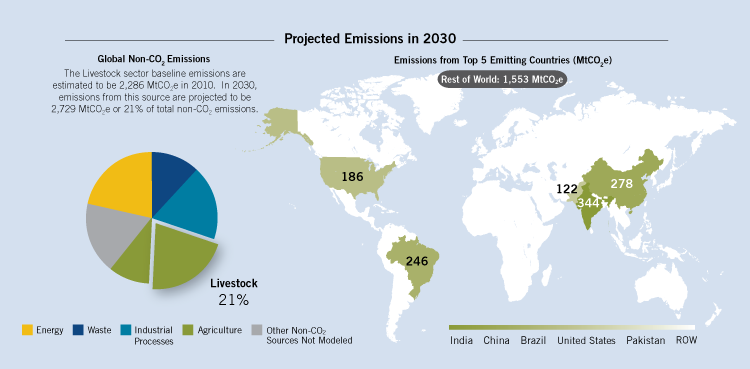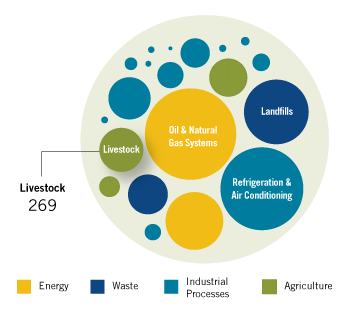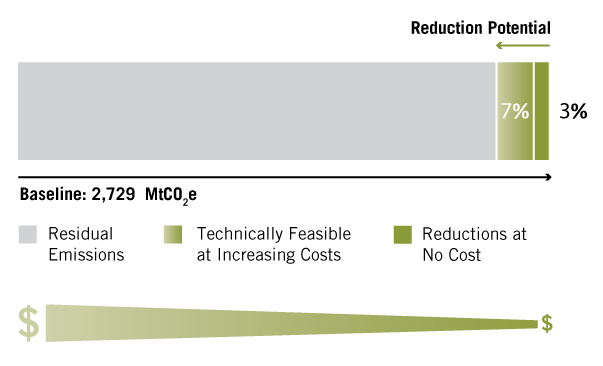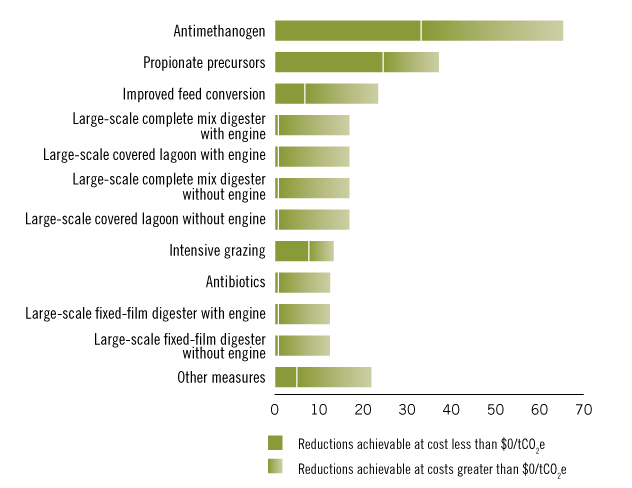Global Mitigation of Non-CO2 Greenhouse Gases: Livestock
Key Points
- The livestock sector accounts for 21% of baseline non-CO2 emissions in 2030.
- The largest low-cost reductions in emissions resulted from implementation of strategies to improve feed conversion efficiency, incorporate feed supplements, and increase the use of small-scale anaerobic digesters.
- The technologically feasible abatement potential of the livestock sector is 267 million metric tons of carbon dioxide equivalent (MtCO2e) in 2030, 10% of baseline emissions.
Sector Description
Livestock operations generate methane (CH4) and nitrous oxide (N2O) emissions. The greenhouse gas emissions mainly come from two sources: enteric fermentation and manure management. Methane is produced as a byproduct of the digestive process in animals through a microbial fermentation process. Manure N2O emissions result from nitrification and denitrification of the nitrogen that is excreted in manure and urine. Global baseline emissions from the livestock sector were estimated to grow from 2,202 to 2,729 MtCO2e from 2010 to 2030.
 View or download the full-size image here.(128 K, PNG)
View or download the full-size image here.(128 K, PNG)
Emissions Reduction Potential
Assuming full implementation of current technology, emissions in the livestock sector could be reduced by up to 269 MtCO2e in 2030. This accounts for 6% of the 4,615 MtCO2e in global reduction potential in 2030.
 View or download the full-size image here.(104 K, PNG)
View or download the full-size image here.(104 K, PNG)
Abatement Potential
Technologically feasible global abatement potential for the livestock sector was estimated at 267 MtCO2e in 2030, a 10% reduction compared to the baseline. In 2030, a reduction of 58 MtCO2e is cost-effective under current projections, and 162 MtCO2e would be possible at an abatement cost of $30/tCO2e.
 It would be cost-effective to reduce emissions by 3%, compared to the baseline, in 2030. An additional 7% reduction is available using technologies with increasingly higher costs.
It would be cost-effective to reduce emissions by 3%, compared to the baseline, in 2030. An additional 7% reduction is available using technologies with increasingly higher costs.
View or download the full-size image here.(36 K, PNG)
Abatement Measures
The report considered six enteric fermentation (CH4) abatement measures: improved feed conversion efficiency, antibiotics, bovine somatotropin (bST), propionate precursors, antimethanogen vaccines, and intensive pasture management. It also included two manure management (N2O) abatement measures: small and large digesters (complete-mix, plugflow, fixed film) and covered lagoons. The largest reductions resulted from implementation of antimethanogen vaccines, propionate precursors, and small digesters.
 Emissions reductions by technology in 2030 at $0/tCO2e and at higher prices.
Emissions reductions by technology in 2030 at $0/tCO2e and at higher prices.
View or download the full-size image here.(52 K, PNG)
